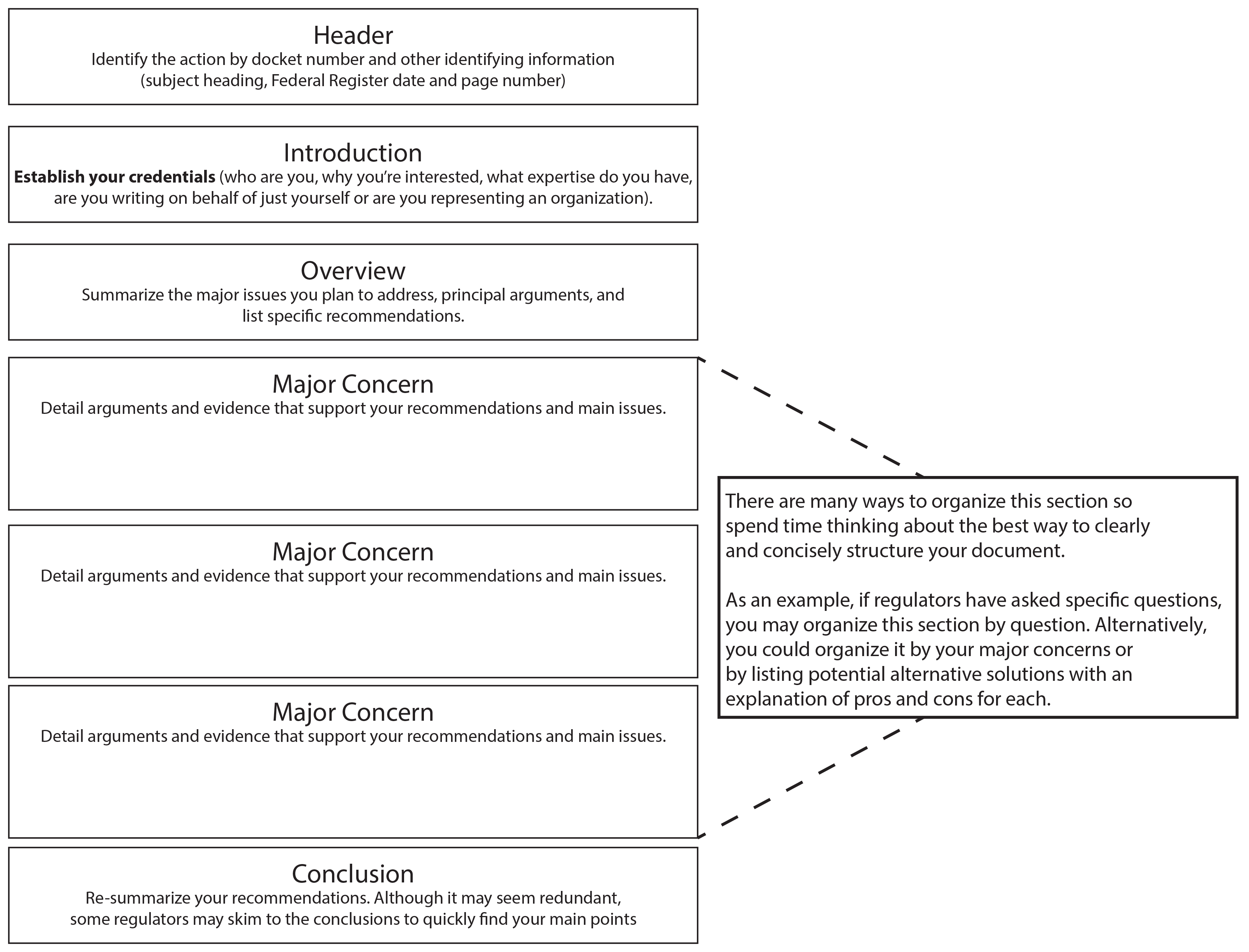Developed in collaboration with Dr. Dan Pomeroy, manager of MIT’s International Policy Lab.
Criteria for success
- Read and understand the proposed regulation.
- Answer any questions posed in the prompt.
- Establish your credentials by stating who you are and why the proposed regulation is relevant to you.
- Provide concrete suggestions and changes to the proposed regulation.
- Support all claims and arguments with evidence.
Structure Diagram
While there is no established format or length for public comments, a well-organized comment will make it easier for regulators to quickly understand your main arguments.
Purpose
Public comments are your opportunity to provide input into the development of regulations proposed by federal agencies (e.g. EPA, FDA, FAA). Generally, comments are written in support or dissent of a proposed regulation. Dissenting comments may also propose alternative policy options.
After the public comment period ends, federal agencies are required to review and respond to issues raised during the comment period, before issuing a final ruling. However, the comment process is not a vote. One well-written comment can outweigh many poorly written or form-letter comments. Therefore, a single comment that provides constructive suggestions backed by evidence is likely to influence the final regulation and may even elicit a request for additional information.
Analyze your audience
Your comment should be addressed to the specific agency or official who posted the proposed regulation. As with other science policy communication, assume regulators reading your comment do not have a scientific background and are ultimately interested in the “real-world” impact of policies. Focus on describing this impact, rather than on scientific details or methodology. For example, estimates of the potential economic effects or human health impacts are often the most effective.
Finally, keep in mind that your comments may be made publicly available and your audience may eventually become the general public.
Skills
Read and understand the regulatory document
Before beginning to write your comment, make sure you have thoroughly read the proposed regulation. In some cases, regulatory agencies will ask for specific comments on particular aspects of a proposed regulation. Be sure you are addressing the specific questions asked and not the questions you wish the regulator would ask.
You don’t have to respond to every issue, but you should at least make sure you have read the entire document before selecting the specific issues to discuss. If there are aspects of the regulatory document that you don’t understand, you can reach out to agency contacts mentioned in the document. The posted notice should list the staff available to contact.
Establish your credentials
To make your comment more persuasive, clearly state your relevant credentials and experience on topics related to the proposed regulations. While personal views and experience are less persuasive than data and facts, stating your professional experiences lends credibility to your comment and increases the chances of persuading regulators to your viewpoint.
Make sure to explain why you personally are writing about the proposed regulation. In some cases, writing about how the proposed regulation will affect you personally may be appropriate.
Make clear and specific recommendations supported by evidence
The most helpful comments provide specific evidence for all claims. Rather than simply stating that you agree or disagree with a proposed regulation, state why you agree or disagree. Make sure to provide arguments supported by data and expert opinions. You should clearly explain how you arrived at any assumptions or estimations. If needed, you can include references in your comment to provide additional data.
If you disagree with a proposed a regulation, provide concrete alternative suggestions (which could include no regulation at all), rather than simply disagreeing. A regulatory agency is more likely to adopt your proposal if you provide an idea they can adopt, rather than general criticism. If you don’t have a specific proposal, you can discuss the pros and cons of other possible regulations.
There will likely be other comments written that support viewpoints contradicting your own. To help regulators parse contradictory arguments, try to refute these alternative viewpoints with specific evidence.
Additional Resources
- A Guide to Writing Public Interest Comments Using Economic Analysis, by Jerry Ellig (Mercatus Center, George Mason University)
- Tips for submitting effective comments, from regulations.gov

